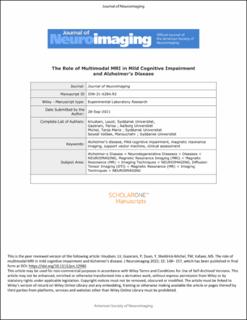| dc.contributor.author | Knudsen, Laust | |
| dc.contributor.author | Gazerani, Parisa | |
| dc.contributor.author | Michel, Tanja Maria | |
| dc.contributor.author | Seyedi Vafaee, Manouchehr | |
| dc.date.accessioned | 2022-02-09T12:56:10Z | |
| dc.date.available | 2022-02-09T12:56:10Z | |
| dc.date.created | 2021-10-04T16:08:27Z | |
| dc.date.issued | 2021-11-09 | |
| dc.identifier.issn | 1051-2284 | |
| dc.identifier.issn | 1552-6569 | |
| dc.identifier.uri | https://hdl.handle.net/11250/2978014 | |
| dc.description.abstract | Background and Purpose: Mild cognitive impairment (MCI) is a prodromal stage of Alzheimer’s Disease (AD), where neurodegeneration is not as considerable, thereby potentially increasing the effect of treatments. Therefore, highly sensitive and specific classification of subjects with MCI is necessary, where various MRI modalities have displayed promise. Methods: Structural, diffusion and resting state (RS) functional MRI analysis were performed on the AD (n=26), MCI (n=5) and healthy control (HC) (n=14) group. Structural analysis was performed via voxel-based morphometry (VBM) and volumetric subcortical segmentation analysis. Fractional anisotropy and mean diffusivity were estimated during the diffusion analysis. RS analysis investigated seed-based functional connectivity. Classification via support vector machine was performed to evaluate which MRI modality most accurately differentiated the groups. Multiple linear regression was conducted to evaluate the MRI modalities correlation with clinical assessment scores. Results: Classification of MCI and N displayed highest accuracy based on diffusion MRI, which besides demonstrated high correlation with clinical scores. Classification was equally accurate in AD, when using VBM or diffusion tensor imaging measures. Yet, more variance was explained by VBM measures in the clinical assessment scores of the AD group. Conclusions: This study highlights the potential of diffusion MRI in differentiating MCI from HC and AD. However, the results need to be interpreted with caution as sample size and artifacts in the MRI data probably influenced the results. | en_US |
| dc.language.iso | eng | en_US |
| dc.publisher | Wiley | en_US |
| dc.relation.ispartofseries | Journal of Neuroimaging (JON);Volume 32, Issue 1 | |
| dc.relation.uri | https://onlinelibrary.wiley.com/doi/10.1111/jon.12940 | |
| dc.subject | Alzheimer’s disease | en_US |
| dc.subject | Clinical assessments | en_US |
| dc.subject | Magnetic resonance imaging | en_US |
| dc.subject | Mild cognitive impairments | en_US |
| dc.subject | Support vector machines | en_US |
| dc.title | The Role of Multimodal MRI in Mild Cognitive Impairment and Alzheimer’s Disease | en_US |
| dc.type | Peer reviewed | en_US |
| dc.type | Journal article | en_US |
| dc.description.version | acceptedVersion | en_US |
| cristin.ispublished | false | |
| cristin.fulltext | original | |
| cristin.qualitycode | 1 | |
| dc.identifier.doi | https://doi.org/10.1111/jon.12940 | |
| dc.identifier.cristin | 1943146 | |
| dc.source.journal | Journal of Neuroimaging (JON) | en_US |
| dc.source.volume | 32 | en_US |
| dc.source.issue | 1 | en_US |
| dc.source.pagenumber | 32 | en_US |
